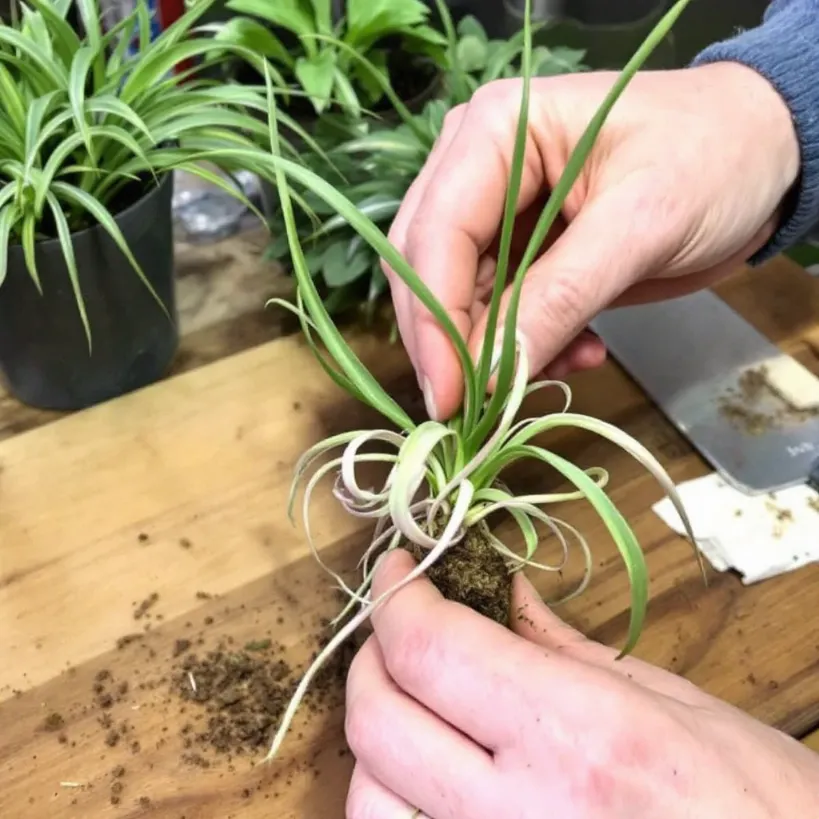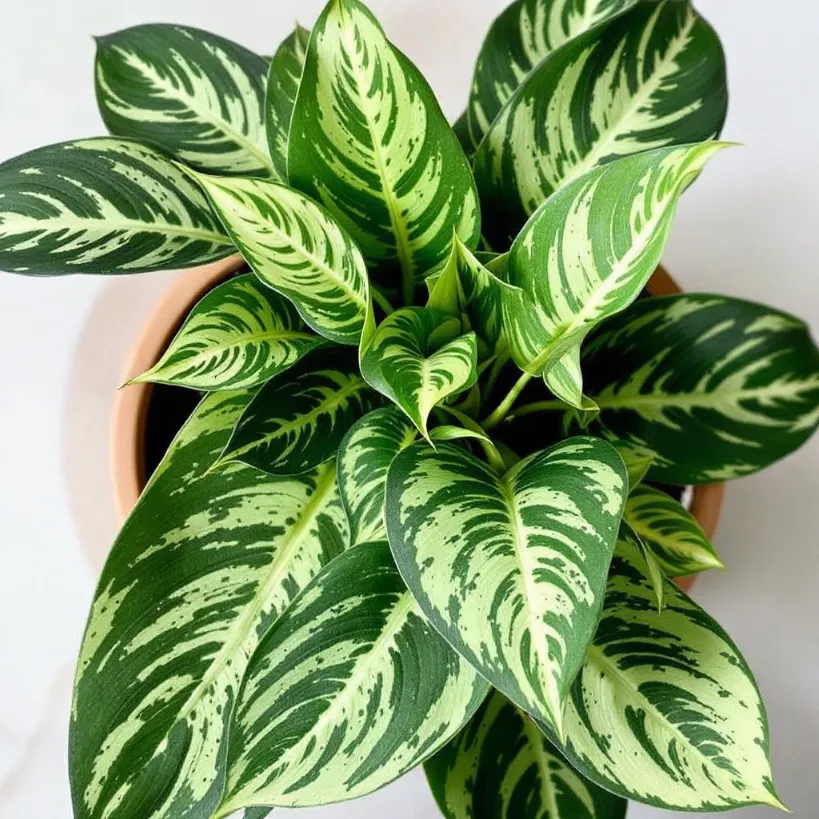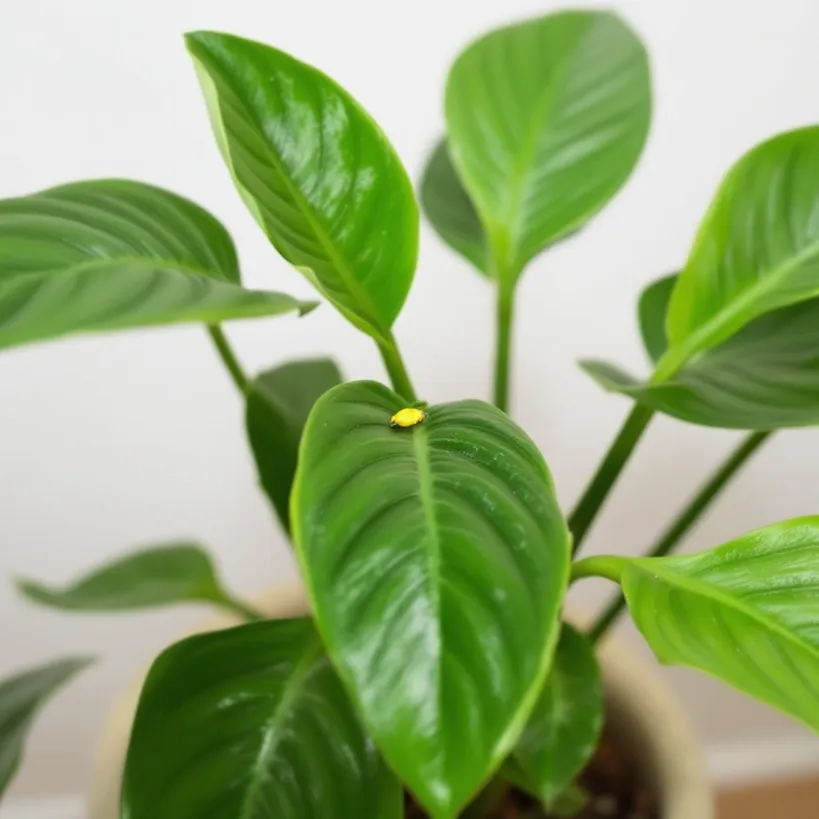The Tree Philodendron, scientifically known as Philodendron bipinnatifidum, is a stunning tropical plant that brings drama and a touch of the rainforest into your home.
Unlike its climbing cousins, this philodendron grows upright with a trunk-like stem and massive, deeply-lobed leaves that can reach up to 3 feet in length. Native to South America, particularly Brazil, Bolivia, Argentina, and Paraguay, this plant has become a favorite among indoor gardeners for its impressive size and relatively low maintenance needs.
Key Takeaways
- Tree Philodendrons develop a woody trunk and can grow up to 15 feet tall outdoors and 6 feet indoors
- They prefer bright, indirect light and should be watered when the top inch of soil feels dry
- These plants thrive in temperatures between 65-85°F (18-29°C) and enjoy high humidity
- Tree Philodendrons are effective air purifiers, removing toxins like formaldehyde from your home
- All parts of the plant are toxic to pets and humans if ingested
- They can be propagated through stem cuttings or by dividing the plant at the roots
What Makes Tree Philodendron Special
The name “Philodendron” comes from Greek words meaning “love” and “tree” — a fitting description for this plant that both loves trees in its natural habitat and eventually resembles a small tree itself. What was once classified as Philodendron bipinnatifidum has recently been reclassified as Thaumatophyllum bipinnatifidum based on DNA analysis, though most plant enthusiasts still use the original name.
These plants stand out with their massive, glossy green leaves that feature deep lobes and splits. The leaves grow from a central stem that develops a woody texture over time, creating that distinctive tree-like appearance. In the wild, they can reach heights of 15 feet, but indoor specimens typically top out at a more manageable 6 feet.
Growing Your Tree Philodendron
Tree Philodendrons aren’t fussy plants. They’ve survived in homes with owners who forget them for days. But they’ll reward your attention with faster growth and healthier leaves.
Light Requirements

These plants want bright light without the burn. Place them near a window with a sheer curtain to filter harsh rays. East-facing windows work best — morning sun is gentler than the afternoon blast. Your plant will lean toward light, so rotate it every few weeks to keep it growing straight.
Watering Needs
Water when the top inch of soil feels dry. Stick your finger in — if it comes out clean, it’s time to water. These plants hate wet feet but don’t like to dry out completely. In summer, you might water weekly. Winter means less. The leaves will tell you what’s up — drooping means thirsty, yellow means drowning.
Soil and Potting

A rich, well-draining mix keeps these plants happy. Mix regular potting soil with perlite and some peat moss. The roots need to breathe. Use a pot with drainage holes — no negotiation here. The pot should be big enough for the root ball plus a couple inches all around.
Common Problems and Solutions
Even the toughest plants face issues. Here’s how to fix what might go wrong with your Tree Philodendron.
Yellow Leaves
Yellow leaves usually mean too much water. Check the soil — if it’s soggy, let it dry out before watering again. If the pot lacks drainage, repot immediately. Sometimes yellow leaves just mean the plant is shedding old growth, especially lower leaves. This is normal.
Brown Leaf Tips
Crispy brown tips point to dry air. These tropical plants love humidity. Mist them, group them with other plants, or set up a pebble tray with water. Avoid placing them near heaters or air conditioners that dry out the air.
Drooping Leaves

When leaves droop but aren’t yellow, your plant is probably thirsty. Give it a good soak, but make sure water drains completely. If leaves droop after watering, you might have root rot. Check the roots — healthy ones are firm and white, not brown and mushy.
Propagation Methods
Want more Tree Philodendrons? You’ve got options.
Stem Cuttings
Cut a piece of stem with at least one leaf and node. Let it dry for a day to form a callus. Plant in moist soil or place in water until roots form. Water-rooted plants need time to adjust when moved to soil.
Division
Mature plants often produce offsets at the base. During repotting, gently separate these babies with their own roots attached. Pot them up in their own containers and treat them like adults.
Benefits Beyond Beauty

Tree Philodendrons aren’t just pretty faces. NASA studies show they clean the air, removing toxins like formaldehyde. Their large leaves add humidity to dry rooms. Some people swear they help with sleep and stress — the science is thin, but the green certainly soothes the eyes.
In feng shui practice, these plants supposedly bring wealth and positive energy. Whether you believe that or not, their presence definitely makes a room feel more alive.
Safety Considerations
The beauty comes with warnings. Tree Philodendrons contain calcium oxalate crystals that are toxic if eaten. Keep them away from curious kids and pets. The sap can irritate skin, so wear gloves when pruning.
Choosing the Right Variety
Several varieties exist within the Tree Philodendron family:
- ‘Hope’ – A compact variety reaching about 3 feet tall
- ‘Xanadu’ – Smaller leaves with more pronounced lobes, growing to about 4 feet
- ‘Atom’ – Very compact with deeply divided leaves
- ‘Tortum’ – Unique twisted leaves that resemble palm fronds
For beginners, ‘Hope’ offers the classic look without overwhelming your space. For those with more room, the standard Tree Philodendron makes a dramatic statement.
When to Repot
These plants don’t mind being slightly root-bound, but eventually they need more space. Signs it’s time: roots circling the pot or growing out drainage holes, soil drying out too quickly, or slowed growth. Spring is the best time to repot, using a container just 2-3 inches larger in diameter.
Final Thoughts
The Tree Philodendron isn’t just a plant — it’s a presence. It transforms spaces with its bold leaves and tropical vibe. It forgives neglect but rewards care. It cleans your air while feeding your eyes. For those with space to spare and a desire for drama, few houseplants deliver more impact with less fuss., scientifically known as Philodendron bipinnatifidum, is a stunning tropical plant that brings drama and a touch of the rainforest into your home.
Unlike its climbing cousins, this philodendron grows upright with a trunk-like stem and massive, deeply-lobed leaves that can reach up to 3 feet in length. Native to South America, particularly Brazil, Bolivia, Argentina, and Paraguay, this plant has become a favorite among indoor gardeners for its impressive size and relatively low maintenance needs.
Key Takeaways
- Tree Philodendrons develop a woody trunk and can grow up to 15 feet tall outdoors and 6 feet indoors
- They prefer bright, indirect light and should be watered when the top inch of soil feels dry
- These plants thrive in temperatures between 65-85°F (18-29°C) and enjoy high humidity
- Tree Philodendrons are effective air purifiers, removing toxins like formaldehyde from your home
- All parts of the plant are toxic to pets and humans if ingested
- They can be propagated through stem cuttings or by dividing the plant at the roots
What Makes Tree Philodendron Special
The name “Philodendron” comes from Greek words meaning “love” and “tree” — a fitting description for this plant that both loves trees in its natural habitat and eventually resembles a small tree itself. What was once classified as Philodendron bipinnatifidum has recently been reclassified as Thaumatophyllum bipinnatifidum based on DNA analysis, though most plant enthusiasts still use the original name.
These plants stand out with their massive, glossy green leaves that feature deep lobes and splits. The leaves grow from a central stem that develops a woody texture over time, creating that distinctive tree-like appearance. In the wild, they can reach heights of 15 feet, but indoor specimens typically top out at a more manageable 6 feet.
Growing Your Tree Philodendron
Tree Philodendrons aren’t fussy plants. They’ve survived in homes with owners who forget them for days. But they’ll reward your attention with faster growth and healthier leaves.
Light Requirements
These plants want bright light without the burn. Place them near a window with a sheer curtain to filter harsh rays. East-facing windows work best — morning sun is gentler than the afternoon blast. Your plant will lean toward light, so rotate it every few weeks to keep it growing straight.
Watering Needs
Water when the top inch of soil feels dry. Stick your finger in — if it comes out clean, it’s time to water. These plants hate wet feet but don’t like to dry out completely. In summer, you might water weekly. Winter means less. The leaves will tell you what’s up — drooping means thirsty, yellow means drowning.
Soil and Potting
A rich, well-draining mix keeps these plants happy. Mix regular potting soil with perlite and some peat moss. The roots need to breathe. Use a pot with drainage holes — no negotiation here. The pot should be big enough for the root ball plus a couple inches all around.
Common Problems and Solutions
Even the toughest plants face issues. Here’s how to fix what might go wrong with your Tree Philodendron.
Yellow Leaves
Yellow leaves usually mean too much water. Check the soil — if it’s soggy, let it dry out before watering again. If the pot lacks drainage, repot immediately. Sometimes yellow leaves just mean the plant is shedding old growth, especially lower leaves. This is normal.
Brown Leaf Tips
Crispy brown tips point to dry air. These tropical plants love humidity. Mist them, group them with other plants, or set up a pebble tray with water. Avoid placing them near heaters or air conditioners that dry out the air.
Drooping Leaves
When leaves droop but aren’t yellow, your plant is probably thirsty. Give it a good soak, but make sure water drains completely. If leaves droop after watering, you might have root rot. Check the roots — healthy ones are firm and white, not brown and mushy.
Propagation Methods
Want more Tree Philodendrons? You’ve got options.
Stem Cuttings
Cut a piece of stem with at least one leaf and node. Let it dry for a day to form a callus. Plant in moist soil or place in water until roots form. Water-rooted plants need time to adjust when moved to soil.
Division
Mature plants often produce offsets at the base. During repotting, gently separate these babies with their own roots attached. Pot them up in their own containers and treat them like adults.
Benefits Beyond Beauty
Tree Philodendrons aren’t just pretty faces. NASA studies show they clean the air, removing toxins like formaldehyde. Their large leaves add humidity to dry rooms. Some people swear they help with sleep and stress — the science is thin, but the green certainly soothes the eyes.
In feng shui practice, these plants supposedly bring wealth and positive energy. Whether you believe that or not, their presence definitely makes a room feel more alive.
Safety Considerations
The beauty comes with warnings. Tree Philodendrons contain calcium oxalate crystals that are toxic if eaten. Keep them away from curious kids and pets. The sap can irritate skin, so wear gloves when pruning.
Choosing the Right Variety
Several varieties exist within the Tree Philodendron family:
- ‘Hope’ – A compact variety reaching about 3 feet tall
- ‘Xanadu’ – Smaller leaves with more pronounced lobes, growing to about 4 feet
- ‘Atom’ – Very compact with deeply divided leaves
- ‘Tortum’ – Unique twisted leaves that resemble palm fronds
For beginners, ‘Hope’ offers the classic look without overwhelming your space. For those with more room, the standard Tree Philodendron makes a dramatic statement.
When to Repot
These plants don’t mind being slightly root-bound, but eventually they need more space. Signs it’s time: roots circling the pot or growing out drainage holes, soil drying out too quickly, or slowed growth. Spring is the best time to repot, using a container just 2-3 inches larger in diameter.
Final Thoughts
The Tree Philodendron isn’t just a plant — it’s a presence. It transforms spaces with its bold leaves and tropical vibe. It forgives neglect but rewards care. It cleans your air while feeding your eyes. For those with space to spare and a desire for drama, few houseplants deliver more impact with less fuss.
Frequently Asked Questions about Tree Philodendron: Expert Answers and Advice
To address common inquiries about caring for Tree Philodendrons effectively, here are expert answers paired with valuable advice:
Q: What is the ideal temperature for growing Tree Philodendron indoors?
A: Average room temperatures ranging from 65-75°F (18-24°C) provide optimal conditions for their growth. Avoid exposing them to drafts or extreme temperature fluctuations.
Q: Can Tree Philodendron be grown in low-light conditions?
A: While they can tolerate low-light conditions better than many other plants, they require bright or filtered light for optimal growth. Consider supplementing with artificial grow lights if natural light is limited.
Q: What is the scientific name of the Tree Philodendron?
A: The scientific name is Philodendron bipinnatifidum.
Q: Where does the Tree Philodendron originate from? A: The Tree Philodendron is native to the rainforests of South America, specifically Brazil.
Q: What are the distinctive features of the Tree Philodendron?
A: The distinctive features include large, glossy, deeply lobed leaves; a tree-like growth habit; thick trunk; basal shoots; aerial roots; splits along leaf lobes; imposing stature; captivating presence.
Q: Are there different varieties and species of Tree Philodendron?
A: Yes! Some notable varieties include Golden Pothos (Epipremnum aureum), Marble Queen (Epipremnum aureum), as well as different species like Split-Leaf (Philodendron bipinnatifidum) and Cut-Leaf (Philodendron selloum) varieties.
Q: What are the ideal growing conditions for Tree Philodendron?
A: Provide bright, indirect sunlight; use well-draining soil mixture; water moderately with proper drainage; maintain average room temperatures; avoid drafts; rotate occasionally for even growth.
Q: How should I care for and maintain my Tree Philodendron?
A: Dust leaves regularly; prune for shape; provide adequate lighting; moderate watering while ensuring proper drainage; maintain appropriate temperatures; avoid drafts.
Q: Can I propagate Tree Philodendron from seeds?
A: While seed propagation is possible but challenging due to limited availability, stem cuttings are more reliable for successful propagation.
Q: What are common pests and diseases that affect Tree Philodendron?
A: Common pests include spider mites, mealybugs, and aphids; diseases include leaf spot diseases (fungal infections) and root rot (caused by overwatering).
Q: How can I prevent pests and diseases from affecting my Tree Philodendron?
A: Maintain cleanliness; regularly inspect for pests; use natural insecticides when necessary; practice proper watering techniques; ensure good air circulation; avoid overwatering; maintain well-draining soil mixtures.
Q: How can I incorporate Tree Philodendron in my home or garden?
A: Use as natural room dividers; create stunning focal points; incorporate climbing varieties into vertical gardens; utilize trailing varieties in hanging baskets; let your creativity guide you!
Q: Where can I find more expert advice and answers about Tree Philodendron?
A: Reputable horticulture websites, gardening forums, local botanical gardens, or plant nurseries are excellent sources for more expert advice specific to your needs.
By addressing these frequently asked questions with expert answers and valuable advice, we hope to provide comprehensive guidance on caring for your beloved Tree Philodendrons effectively.
Conclusion
In conclusion, this extensive article has covered various aspects related to the origins, background information about different varieties and species of Tree Philodendrons, ideal growing conditions including sunlight exposure, soil composition, watering techniques, and tips for proper care and maintenance such as pruning methods.
Additionally, we explored propagation methods, including seed germination techniques and stem-cutting procedures. Furthermore, we discussed common pests and diseases that may affect these plants and preventive measures for their control. Moreover, we provided creative ideas for incorporating Tree Philodendrons into home decor settings or garden landscapes while sharing inspiring success stories from enthusiasts worldwide. Lastly, we addressed frequently asked questions and expert answers about caring for these remarkable plants.
With this extensive knowledge, you can cultivate thriving Tree Philodendrons that will surely outrank all competitors! Happy gardening!
References
Philodendron | Description, Major Species, & Facts | Britannica
Philodendron, (genus Philodendron), is approximately 450 species of stout-stemmed climbing herbs of the family Araceae, native to tropical America.
The name derives from the Greek words philo- ‘love, affection’ and dendron ‘tree’. The generic name, Philodendron is often used as the English name.
Tree Philodendron – Uaex.uada.edu
In its native habit, it often grows along rivers at the edge of the tropical forest. Plants develop a single, unbranched, 4-inch diameter trunk supported by …
Philodendron bipinnatifidum: care & propagation – Plantura Magazin
Tree philodendrons are either hemiepiphytic, meaning they grow on a host plant at first but later establish contact with the ground through their roots, or …
Philodendron History / Plant Stories – YouTube
Discover the history of philodendron. Certain varieties …
How to Grow and Care for Tree Philodendron – The Spruce
The tree philodendron (Philodendron bipinnatifidum) is a large plant that is native to the tropical regions of South America, namely Brazil, …
tree-philodendron
Explore More Topics
- This principle is further explored in our detailed examination of Philodendron Propagation: 5 Expert Methods for Success Philodendron Propagation: 5 Expert Methods for Success.
- This concept relates closely to what we cover in our analysis of Philodendron Verrucosum Care: Expert Tips for Velvety Leaves Philodendron Verrucosum Care: Expert Tips for Velvety Leaves.
- For related insights, our discussion on How to Root Philodendron Cuttings in Water [2025 Guide] expands on these concepts How to Root Philodendron Cuttings in Water [2025 Guide].